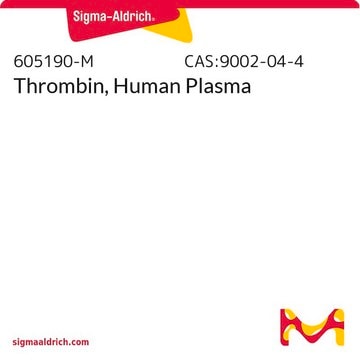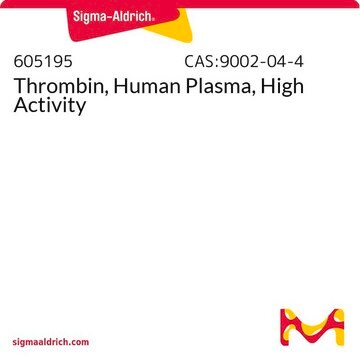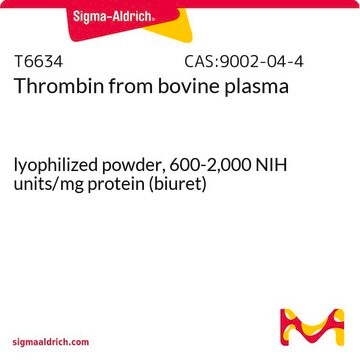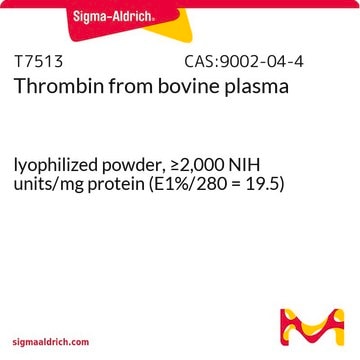T7572
Thrombin from human plasma
400-1000 NIH units/mg protein
Synonym(s):
Factor IIa
Sign Into View Organizational & Contract Pricing
All Photos(1)
About This Item
Recommended Products
form
lyophilized powder
Quality Level
specific activity
400-1000 NIH units/mg protein
impurities
HIV, hepatitis B and hepatitis C, tested negative
UniProt accession no.
storage temp.
−20°C
Gene Information
human ... F2(2147)
Looking for similar products? Visit Product Comparison Guide
General description
Lyophilized powder containing sucrose, sodium chloride and Tris.
Thrombin is the final coagulation protease in regard to hemostasis, promoting both procoagulant and anticoagulant effects.
Application
Thrombin is used for site specific cleavage of recombinant fusion proteins containing an accessible thrombin recognition site for removal of affinity tags. Thrombin has been used in a study to assess an innovative flow cytometric approach for small-size platelet microparticles.
Biochem/physiol Actions
Serine protease that selectively cleaves Arg-Gly bonds in fibrinogen to form fibrin and fibrinopeptides A and B.
Unit Definition
Activity is expressed in NIH units obtained by direct comparison to a NIH Thrombin Reference Standard
Analysis Note
The NIH assay procedure uses 0.2 ml diluted plasma (1:1 with saline) as a substrate and 0.1ml of thrombin sample (stabilized in a 1% buffered albumin solution) based on a modification of the method of Biggs. Only clotting times in the range of 15-25 seconds are used for determining thrombin concentrations.
Other Notes
View more information on thrombin at www.sigma-aldrich.com/enzymeexplorer.
Disclaimer
RESEARCH USE ONLY. This product is regulated in France when intended to be used for scientific purposes, including for import and export activities (Article L 1211-1 paragraph 2 of the Public Health Code). The purchaser (i.e. enduser) is required to obtain an import authorization from the France Ministry of Research referred in the Article L1245-5-1 II. of Public Health Code. By ordering this product, you are confirming that you have obtained the proper import authorization.
Choose from one of the most recent versions:
Certificates of Analysis (COA)
Lot/Batch Number
Don't see the Right Version?
If you require a particular version, you can look up a specific certificate by the Lot or Batch number.
Already Own This Product?
Find documentation for the products that you have recently purchased in the Document Library.
Customers Also Viewed
An innovative flow cytometric approach for small-size platelet microparticles: influence of calcium.
Silvia Montoro-García et al.
Thrombosis and haemostasis, 108(2), 373-383 (2012-06-29)
Microparticles (MPs) are small submicron membrane-derived vesicles shed from a variety of cells and they have been implicated in different disorders. Accordingly, understanding of physiological characteristics of MPs and improvement of methods of their quantification are important for further advance
At the cutting edge: conformational PARtiality.
T Madhusudhan et al.
Journal of thrombosis and haemostasis : JTH, 10(8), 1672-1674 (2012-06-30)
Herbert Nar
Trends in pharmacological sciences, 33(5), 279-288 (2012-04-17)
The quest for novel medications to treat thromboembolic disorders such as venous thrombosis, pulmonary embolism and stroke received a boost when the 3D structures of two major players in the blood coagulation cascade were determined in 1989 and 1993. Structure-guided
Jawed Fareed et al.
Annual review of pharmacology and toxicology, 52, 79-99 (2011-08-09)
Since the discovery of heparin nearly a century ago, there have been large gaps in the development of anticoagulants. The discovery of warfarin was the first step toward using oral anticoagulants, but warfarin use has been associated with its own
Christopher S King et al.
Chest, 143(4), 1106-1116 (2013-04-03)
Thromboembolic diseases are common. Heparins and the vitamin K antagonists have been the mainstay of therapy for > 60 years, but both classes of agents have limitations. The "ideal" anticoagulant should be as effective and safe as heparin and vitamin
Our team of scientists has experience in all areas of research including Life Science, Material Science, Chemical Synthesis, Chromatography, Analytical and many others.
Contact Technical Service









